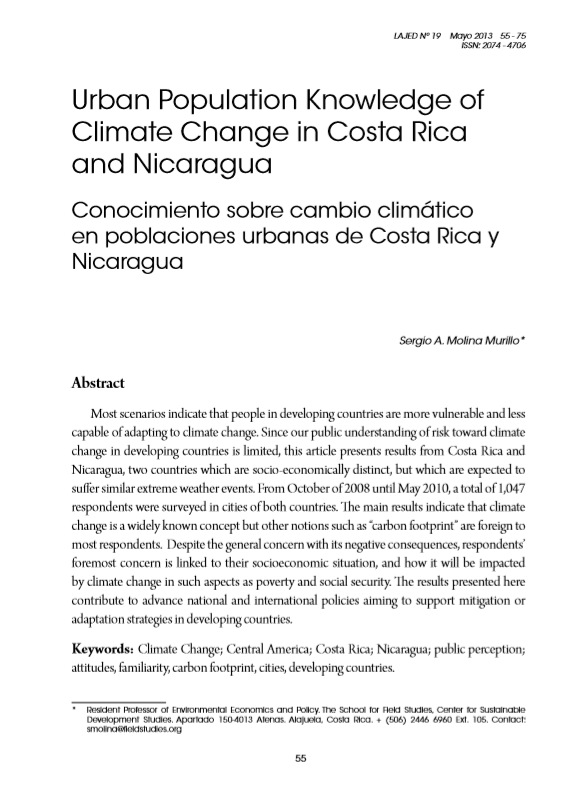Urban Population Knowledge of Climate Change in Costa Rica and Nicaragua
DOI:
https://doi.org/10.35319/lajed.201319108Keywords:
Climate Change, Central America, Costa Rica, Nicaragua, public perception, attitudes, familiarity, carbon footprint, cities, developing countriesAbstract
Most scenarios indicate that people in developing countries are more vulnerable and less capable of adapting to climate change. Since our public understanding of risk toward climate change in developing countries is limited, this article presents results from Costa Rica and Nicaragua, two countries which are socio-economically distinct, but which are expected to suffer similar extreme weather events. From October of 2008 until May 2010, a total of 1,047 respondents were surveyed in cities of both countries. The main results indicate that climate change is a widely known concept but other notions such as “carbon footprint” are foreign to most respondents. Despite the general concern with its negative consequences, respondents’ foremost concern is linked to their socioeconomic situation, and how it will be impacted by climate change in such aspects as poverty and social security. The results presented here contribute to advance national and international policies aiming to support mitigation or adaptation strategies in developing countries.
Downloads
References
Ajzen, I. (1991). The theory of planned behavior. Organizational Behavior and Human Decision Processes, 50,179-211.
Bandura, A. (1986). Social foundations of thought and action: a social cognitive theory. Englewood Cliffs, N.J., Prentice-Hall.
Bonniface, L. and Henley, N. (2008). A drop in the bucket: Collective efficacy perceptions and environmental behavior. Australian Journal of Social Issues, 43(3), 345-360.
Bord, R.J., O’Connor, R.E. and Fischer, A. (1998). Public Perceptions of Global Warming: United States and International Perspectives. Climate Research, 11, 75-84.
---------- (2000). In what sense does the public need to understand global climate change? Public Understanding of Science, 9(3), 205-218.
Bostrom, A., Granger, M., Fischhoff, B. and Read, D. (1994). What Do People Know About Climate Change? Risk Analysis, 14(6), 959-970.
Boza, M. (1993). Conservation in action: Past, present, and future of the national parks system in Costa Rica, Conservation Biology, 7(2), 239-47.
Browne, J. (2004). Beyond Kyoto. Foreign Affairs, 83(4), 20-32.
Charveriat, C. (2000). Natural Disasters in Latin America and the Caribbean: An Overview of Risk. Inter-American Development Bank working paper #434. Available at: http://www.iadb.org/res/publications/pubfiles/pubWP-434.pdf
ENCC. (2010). Costa Rica´s National Strategy on Climate Change Homepage. Available at: www.encc.go.cr.
EuropeAid. (2009). Climate change in Latin America. AGRIFOR Consult Group. http://ec.europa.eu/europeaid/where/latin-america/regional-cooperation/documents/climate_change_in_latin_america_en.pdf
Evans, S. (1999). The Green Republic: A Conservation History of Costa Rica. Austin, Texas: University of Texas Press.
Fournier-Origgi, L. (1991). Desarrollo y perspectivas del movimiento conservacionista costarricense. San Jose, Costa Rica. University of Costa Rica. 72 Urban Population Knowledge of Climate Change in Costa Rica and Nicaragua
Gifford, R. (2011). The dragons of inaction: Psychological barriers that limit climate change mitigation and adaptation. American Psychologist, 66(4), 290-302.
Gowdy, J.M. (2008). Behavioral economics and climate change policy. Journal of Economic Behavior and Organization, 68, 632-644.
Hahn, R.W. and Stavins R.N. (1991). Economic incentives for environmental protection: Integrating theory and practice. CSIA Discussion Paper 91-15.
Hardin, G. (1968). The tragedy of the commons. Science, 162(3859), 1243-1248.
Holl, K.D., Daily,G.D., and Ehrlich, P.R. 1995. Knowledge and perceptions in Costa Rica regarding environment, population, and biodiversity. Conservation Biology, 9(6), 1548-1558.
Intergovernmental Panel on Climate Change [IPCC] (2007). The Fourth Assessment Report (AR4): Climate Change 2007. www.ipcc.ch/ipccreports/assessmentsreports.htm.
Johnson, D. and Levin, S. (2009). The tragedy of cognition: psychological biases and environmental inaction. Current Science, 97(11), 1593-1603.
Jones, P.G. and Thornton, P.K. (2003). The potential impacts of climate change on maize production in Africa and Latin America in 2055. Global Environmental Change, 13(1), 51-59.
Kempton, W. (1991). Lay perspectives on global climate change. Global Environmental Change, 1(3), 183-208.
Leiserowitz, A. (2005). American risk perceptions: Is climate change dangerous? Risk Analysis, 25(6), 1433-1442.
---------- (2006). Climate change risk perception and policy preferences: The role of affect, imagery and values. Climatic Change, 77, 45-72
Leiserowitz, A., Smith, N. and Marlon, J.R. (2010). Americans’ Knowledge of climate change. Yale University. New Haven, CT: Yale Project on Climate Change Communication. http://environment.yale.edu/climate/files/ClimateChangeKnowledge2010.pdf
Lindenberg, S. and Steg, L. (2007). Normative, gain and hedonic goal frames guiding environmental behavior. Journal of Social Issues, 63(1), 117-137.
Maddison, D. (2007). The perception of and adaptation to climate change in Africa. World Bank Policy Research Working Paper, The World Bank.
Mitchell, T. D., and Hulme, M. (2000). A country-by-country analysis of past and future warming rates. Tyndall Centre for Climate Change Research. Working Paper No. 1. Norwich, U.K., Available at: http://www.cru.uea.ac.uk/~timm/papers/tyn-wp1.pdf
Myers, M. C. (2001). Economic development policy and the protected areas system in Costa Rica: A historical review and prospects for the future. Vida Silvestre Neotropical, 10(1-2), 3-19.
O’Connor, R. E., Bord, R. J., Fisher, A. (1999). Risk perceptions, general environmental beliefs, and willingness to address climate change. Risk Analysis, 19(3), 461-471.
Prochaska J.O., Velicer, W.F. (1997). The transtheoretical model of health behavior change. American Journal of Health Promotion, 12, 38-48.
Semenza, J.C., Hall, D.E., Wilson, D.J., Bontempo, B.D., Sailor, D.J. and George, L.A. (2008). Public perception of climate change: Voluntary mitigation and barriers to behavior change. American Journal of Preventive Medicine, 35(5), 479-487.
Stern, N. (2007). The Economics of Climate Change. New England Journal of Public Policy, 21(2), 23-50.
World Bank. (2009). World Development Report 2010: Development and Climate Change. Available at www.wb.org/wdr2010
World Health Organization [WHO] (2000). The World Health Report 2000 - Health systems: improving performance. Available at: http://www.who.int/whr/2000/en/index.htm






